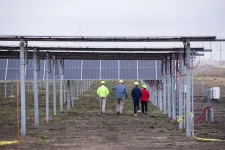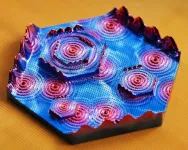(Press-News.org) Following three years of intensive research, an international team of researchers have compiled the first ever ‘World Cybercrime Index’, which identifies the globe’s key cybercrime hotspots by ranking the most significant sources of cybercrime at a national level.
The Index, published today in the journal PLOS ONE, shows that a relatively small number of countries house the greatest cybercriminal threat. Russia tops the list, followed by Ukraine, China, the USA, Nigeria, and Romania. The UK comes in at number eight.
Co-author of the study, Dr Miranda Bruce from the University of Oxford and UNSW Canberra said the study will enable the public and private sectors to focus their resources on key cybercrime hubs and spend less time and funds on cybercrime countermeasures in countries where the problem is not as significant.
“The research that underpins the Index will help remove the veil of anonymity around cybercriminal offenders, and we hope that it will aid the fight against the growing threat of profit-driven cybercrime,” Dr Bruce said.
“We now have a deeper understanding of the geography of cybercrime, and how different countries specialise in different types of cybercrime.”
“By continuing to collect this data, we’ll be able to monitor the emergence of any new hotspots and it is possible early interventions could be made in at-risk countries before a serious cybercrime problem even develops.”
The data that underpins the Index was gathered through a survey of 92 leading cybercrime experts from around the world who are involved in cybercrime intelligence gathering and investigations. The survey asked the experts to consider five major categories of cybercrime*, nominate the countries that they consider to be the most significant sources of each of these types of cybercrime, and then rank each country according to the impact, professionalism, and technical skill of its cybercriminals.
Co-author Associate Professor Jonathan Lusthaus, from the University of Oxford’s Department of Sociology and Oxford School of Global and Area Studies, said cybercrime has largely been an invisible phenomenon because offenders often mask their physical locations by hiding behind fake profiles and technical protections.
“Due to the illicit and anonymous nature of their activities, cybercriminals cannot be easily accessed or reliably surveyed. They are actively hiding. If you try to use technical data to map their location, you will also fail, as cybercriminals bounce their attacks around internet infrastructure across the world. The best means we have to draw a picture of where these offenders are actually located is to survey those whose job it is to track these people,” Dr Lusthaus said.
Co-author of the study, Professor Federico Varese from Sciences Po in France, said the World Cybercrime Index is the first step in a broader aim to understand the local dimensions of cybercrime production across the world.
“We are hoping to expand the study so that we can determine whether national characteristics like educational attainment, internet penetration, GDP or levels of corruption are associated with cybercrime. Many people think that cybercrime is global and fluid, but this study supports the view that, much like forms of organised crime, it is embedded within particular contexts,” Professor Varese said.
The World Cybercrime Index has been developed as a joint partnership between the University of Oxford and UNSW and has also been funded by CRIMGOV, a European Union-supported project based at the University of Oxford and Sciences Po. The other co-authors of the study include Professor Ridhi Kashyap from the University of Oxford and Professor Nigel Phair from Monash University.
For media enquiries and interview requests, contact: Dr Miranda Bruce; email: miranda.bruce@unsw.edu.au
Media support (UK /US): Dr Caroline Wood, University of Oxford; ph. 01865 280534; email: caroline.wood@admin.ox.ac.uk
Media support (Australia): Damon Whittock, UNSW Canberra; ph. 0404 489 376; email: d.whittock@adfa.edu.au
The study ‘Mapping the global geography of cybercrime with the World Cybercrime Index’ will be published in the journal PLOS ONE at 19:00 BST / 14:00 ET Wednesday 10 April at: https://journals.plos.org/plosone/article?id=10.1371/journal.pone.0297312 This link will go live once the embargo lifts. To view a copy of the paper before this under embargo, contact caroline.wood@admin.ox.ac.uk
*The five major categories of cybercrime assessed by the study were:
1. Technical products/services (e.g. malware coding, botnet access, access to compromised systems, tool production).
2. Attacks and extortion (e.g. denial-of-service attacks, ransomware).
3. Data/identity theft (e.g. hacking, phishing, account compromises, credit card comprises).
4. Scams (e.g. advance fee fraud, business email compromise, online auction fraud).
5. Cashing out/money laundering (e.g. credit card fraud, money mules, illicit virtual currency platforms).
About the University of Oxford
Oxford University has been placed number 1 in the Times Higher Education World University Rankings for the eighth year running, and number 3 in the QS World Rankings 2024. At the heart of this success are the twin-pillars of our ground-breaking research and innovation and our distinctive educational offer.
Oxford is world-famous for research and teaching excellence and home to some of the most talented people from across the globe. Our work helps the lives of millions, solving real-world problems through a huge network of partnerships and collaborations. The breadth and interdisciplinary nature of our research alongside our personalised approach to teaching sparks imaginative and inventive insights and solutions.
Through its research commercialisation arm, Oxford University Innovation, Oxford is the highest university patent filer in the UK and is ranked first in the UK for university spinouts, having created more than 300 new companies since 1988. Over a third of these companies have been created in the past five years. The university is a catalyst for prosperity in Oxfordshire and the United Kingdom, contributing £15.7 billion to the UK economy in 2018/19, and supports more than 28,000 full time jobs.
END
World-first “Cybercrime Index” ranks countries by cybercrime threat level
2024-04-10
ELSE PRESS RELEASES FROM THIS DATE:
A study in Science Advances suggests liquid biopsy could detect and monitor aggressive small cell lung cancer
2024-04-10
A new lab assay developed by researchers at Fred Hutch Cancer Center could make diagnosis and treatment of small-cell lung cancer and non-small cell lung cancer easier.
The blood-based test, also called a “liquid biopsy,” can detect differences between types of lung cancer by examining patterns in cell-free tumor DNA in blood samples. It’s a desirable option for detecting small-cell lung cancer (SCLC) as standard needle biopsies fail due the number of smaller tumors typically present and the variety of tumor subtypes that indicate different treatment pathways.
“There ...
New drug prevents flu-related inflammation and lung damage
2024-04-10
(MEMPHIS, Tenn. – April 10, 2024) Infection with the influenza virus leads to lung injury through inflammation over-activation that causes collateral damage to cells required for breathing. Such damage can be life-threatening, but scientists have a new preventative treatment. A team from St. Jude Children’s Research Hospital, University of Houston, Tufts University School of Medicine and Fox Chase Cancer Center created a drug that can prevent flu-induced lung injury. In a mouse model, the ...
Taking on the global challenge of hidden hunger
2024-04-10
COLUMBIA, Mo. — More than 2 billion people suffer from hidden hunger, a form of malnutrition where individuals lack essential micronutrients — like vitamins and minerals — even though they consume what appears to be an adequate amount of calories.
University of Missouri researcher Kiruba Krishnaswamy is focused on tackling this global challenge. She recently received a five-year, $532,000 Early Career Development (CAREER) award from the National Science Foundation (NSF) — the NSF’s most prestigious award for early-career faculty — in support of her project titled ...
Engineers making a better, more profitable grid for distributing solar power
2024-04-10
AMES, Iowa – If you’re the Midcontinent Independent System Operator – the organization that manages the flow of high-voltage electricity across a central stripe of the U.S. and Canada, from Manitoba, Michigan and Minnesota through Iowa and all the way to Louisiana – you want energy supplies to meet the energy demands of 45 million people.
“We make sure the right amount of electricity is generated and transmitted to our member utilities,” says the regional grid operator’s website.
Balancing power supply and demand is complicated these days. Electricity is no longer exclusively generated by power plants using coal- or natural ...
Initiative increases awareness of the threats posed by light pollution to the global ocean
2024-04-10
Scientists, policy makers, and marine and environmental professionals across the world are being encouraged to sign up to a new initiative highlighting some of the global threats posed by light pollution.
The Global Ocean Artificial Light at Night Network (GOALANN) has been launched today at the United Nations Ocean Decade Conference in Barcelona.
It has been established by ecologists, oceanographers and social scientists who have spent more than a decade studying the impact of light pollution on the ocean, and the many species living in or near it.
The GOALANN network aims to expand on the impact of that work, unifying research groups ...
How the body switches out of “fight” mode
2024-04-10
Joint press release of Charité and Uniklinikum Erlangen
Cortisone and other related glucocorticoids are extremely effective at curbing excessive immune reactions. But previously, astonishingly little was known about how they exactly do that. A team of researchers from Charité – Universitätsmedizin Berlin, Uniklinikum Erlangen and Ulm University have now explored the molecular mechanism of action in greater detail. As the researchers report in the journal Nature,* glucocorticoids reprogram ...
Physicists discover a novel quantum state in an elemental solid
2024-04-10
Physicists have observed a novel quantum effect termed “hybrid topology” in a crystalline material. This finding opens up a new range of possibilities for the development of efficient materials and technologies for next-generation quantum science and engineering.
The finding, published in the April 10th issue of Nature, came when Princeton scientists discovered that an elemental solid crystal made of arsenic (As) atoms hosts a never-before-observed form of topological quantum behavior. They were able to explore and image this ...
Researchers show chemical found naturally in cannabis may reduce anxiety-inducing effects of THC
2024-04-10
FOR IMMEDIATE RELEASE
A Johns Hopkins Medicine-led research team has added to evidence that a chemical found naturally in cannabis (also known as marijuana) can — in the right amounts — lessen the anxiety-inducing effects of tetrahydrocannabinol (THC), the primary psychoactive sister chemical found in cannabis. The finding has the potential to advance the medicinal use of THC, and reduce the risks of its recreational use in some people.
The substance, called d-limonene, is one of the most abundant terpenes, or essential oils, in the cannabis plant, and has shown promise in rodent studies in reducing anxiety behaviors. However, there has ...
AI-powered ‘sonar’ on smartglasses tracks gaze, facial expressions
2024-04-10
ITHACA, N.Y. – Cornell University researchers have developed two technologies that track a person’s gaze and facial expressions through sonar-like sensing. The technology is small enough to fit on commercial smartglasses or virtual reality or augmented reality headsets, yet consumes significantly less power than similar tools using cameras.
Both use speakers and microphones mounted on an eyeglass frame to bounce inaudible soundwaves off the face and pick up reflected signals caused by face and eye movements. ...
Newly found genetic variant defends against Alzheimer’s disease
2024-04-10
NEW YORK, NY (April 10, 2024)--Columbia researchers have discovered a genetic variant that reduces the odds of developing Alzheimer’s disease by up to 70% and may be protecting thousands of people in the United States from the disease.
The discovery of the protective variant, which appears to allow toxic forms of amyloid out of the brain and through the blood-brain barrier, supports emerging evidence that the brain’s blood vessels play a large role in Alzheimer's disease and could herald a new direction in therapeutic development.
“Alzheimer’s disease may get started with amyloid deposits in the brain, but ...






